SanDisk Professional Pro-Blade review: Fast, but an answer to a question nobody is asking
SanDisk Professional's Pro-Blade SSD is a modular storage system that has good enough speed, and is reasonably compact, but it needs time to evolve and see greater adoption.
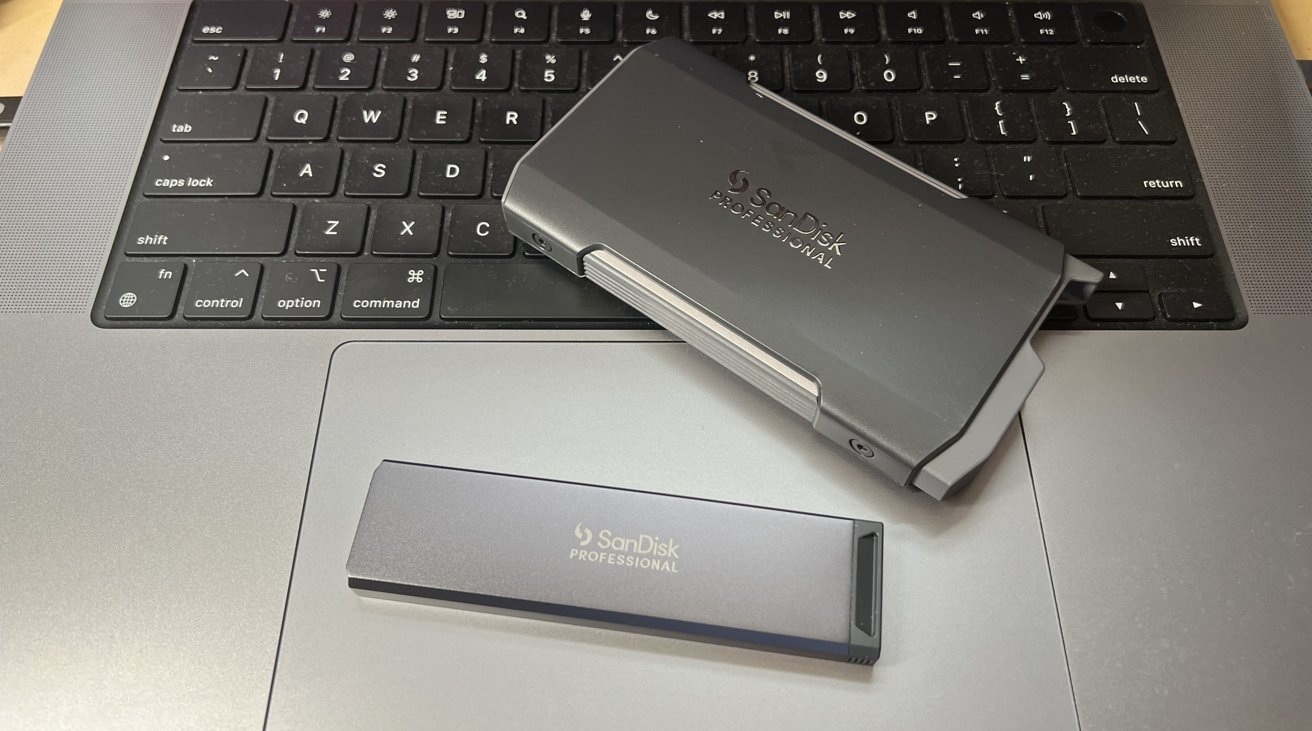
SanDisk Professional Pro-Blade Transport and SSD Mag
Most of the AppleInsider staff used Zip disks in their heyday. For those that didn't, they were portable magnetic media a bit larger than a floppy disk that slotted into a relatively inexpensive drive.
Most of the major manufacturers adopted them as at least an option. Apple did too.
But for many reasons, they faded into obscurity. Data density was one issue, and so was reliability on not just it, but its larger cousin, the Jaz drive. And, they were mostly replaced with flash drives.
Fast forward about two decades to today, and SanDisk has resurrected the idea of removable media in a custom enclosure with the idea of the flash drive, resulting in the SanDisk Professional Pro-Blade Transport system. The Pro-Blade ecosystem revolves around high-speed SSD "Mags," which are slimline and lightweight, and hold the actual media.
To interface them with your Mac, you at a minimum need the SanDisk Pro-Blade Transport. That enclosure is effectively the main enclosure for an external drive, but without the drive itself.
The theory is that you have one or relatively few Transports, but lots of SSD Mags. Tried and true model, once upon a time.
In effect, the Transport is a specialized hard drive docking station or "toaster." Except it's in a much smaller form.
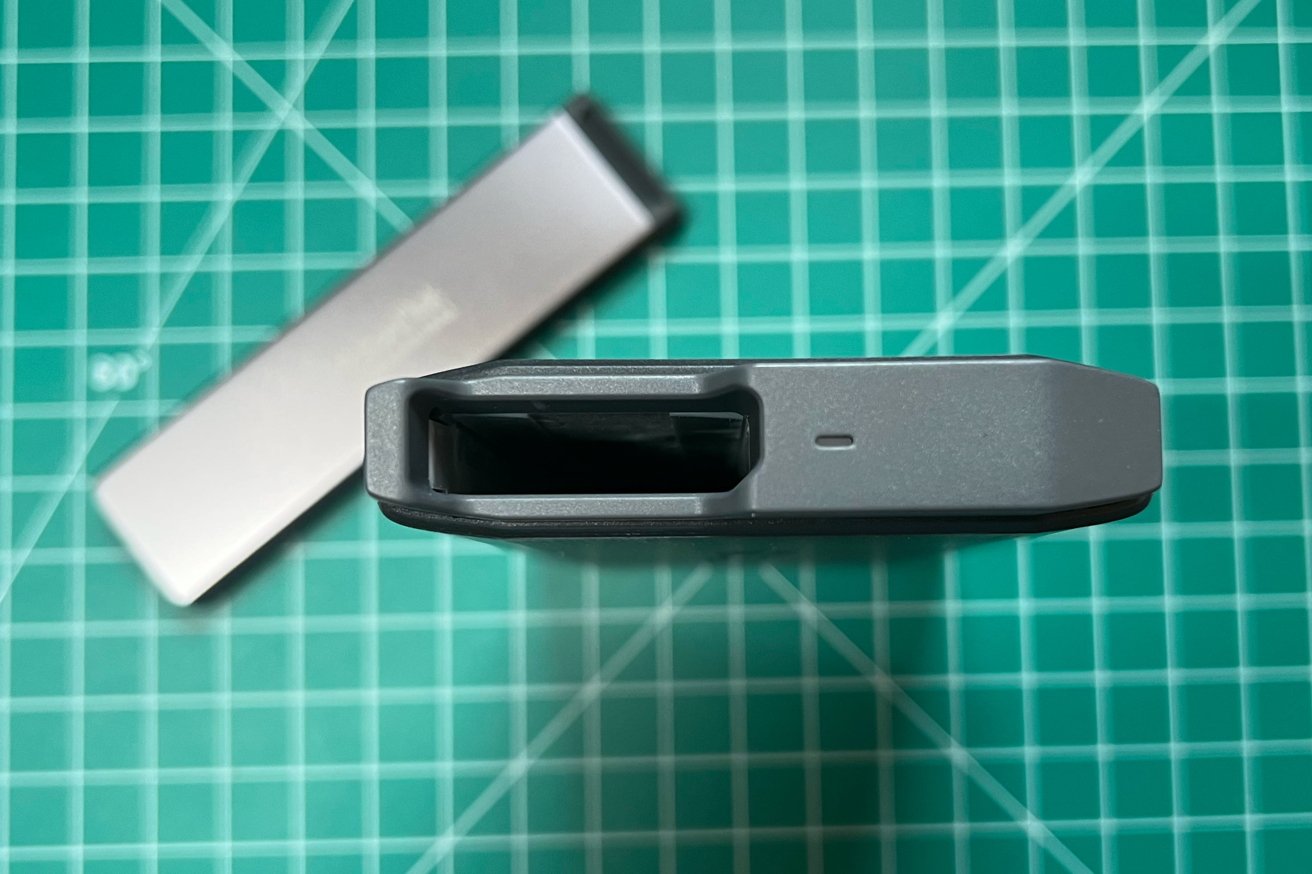
The slot of the Pro-Blade Transport where you place the SSD Mags
Made from aluminum complete with an aluminum heatsink to help cool the SSD Mags, the Transport is a relatively straightforward docking element. On one end is the slot where the SSD Mag fits in, along with an indicator light.
The slot is made so that you can easily insert and pull out the SSD Mag, so that you can quickly switch between Mags without too much interference.
At the other end is just one port, a USB-C 3.2 Gen 2x2 connection with up to 20Gbps of bandwidth available to use. That is, assuming your Mac supports it -- more on this in a bit.
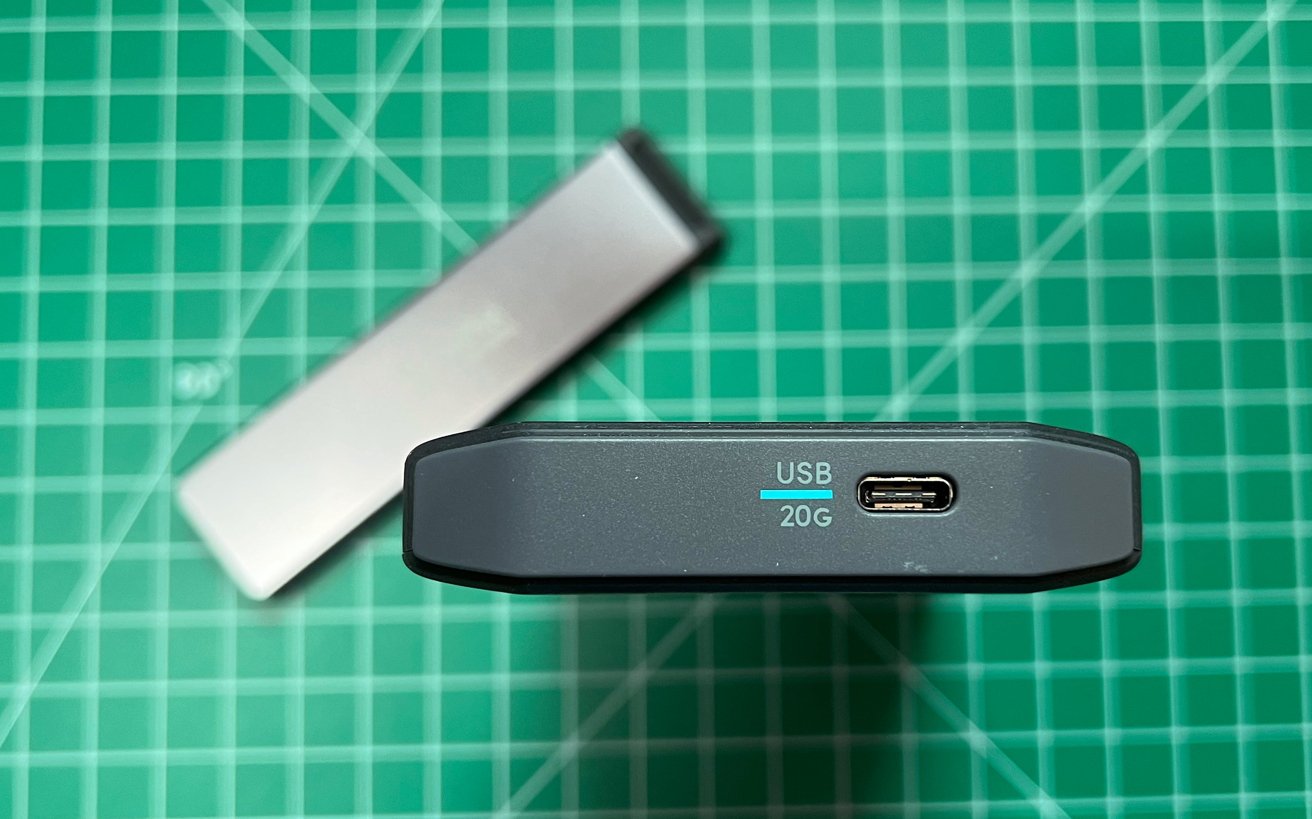
There's a 20Gbps USB-C port to connect the Pro-Blade Transport to your Mac.
As an enclosure, it's also reasonably sized at 5.13 inches long, 2.82 inches wide, and 0.63 inches thick. It's fairly lightweight when empty at 0.46 pounds. This is still much bigger than the recent crop of NVMe USB-C enclosures.
It can be used on both Macs and Windows, with support for macOS 10.13 or later and Windows 10, though you will have to reformat the Mags. For the former, it is compatible with Time Machine, though admittedly this is better suited for work-use drives rather than backups.
The other end has the connector that couples to its counterpart deep inside the Transport. It will also work with the Pro-Blade Station, a more enhanced form of the Transport that can take up to four Mags.
However, this isn't a standard connector that will work outside of the system itself. You cannot directly connect the drive alone to your Mac, you must use the Transport.
Each Mag is very light at a tenth of a pound each. They're not quite as long at 4.32 inches, but they're also a lot thinner and narrower at 1.1 inches and 0.2 inches.
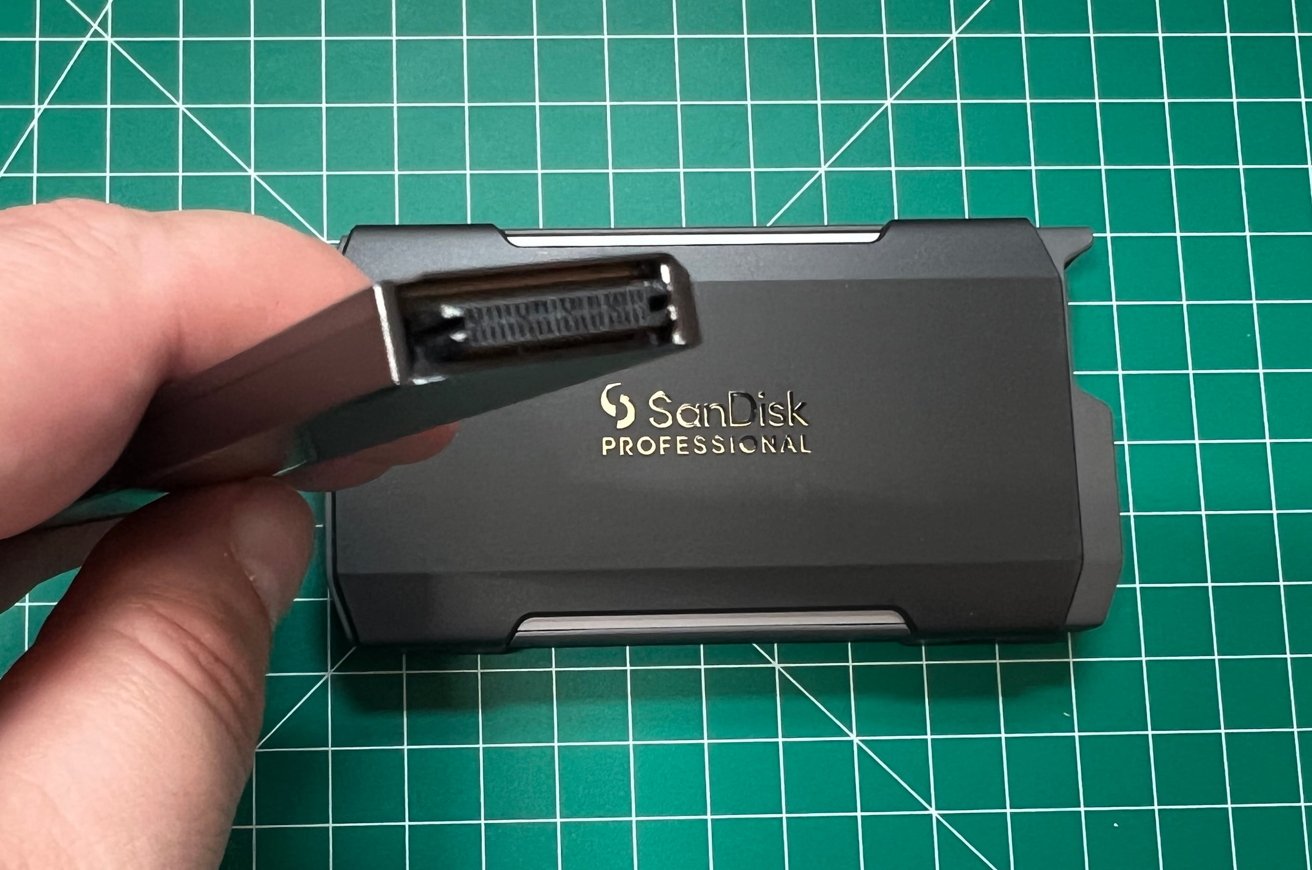
The SSD Mag's connector.
Despite their size, SanDisk worked to make each one durable. Away from the Transport, each blade can withstand a 3-meter (9.8ft) drop, and can survive being crushed by a 4,000-pound weight.
We did run one over with our minivan, and it survived, intact and readable. Scuffed, but intact.
So far, there are four different capacities of Pro-Blade SSD Mag available, including 1TB, 2TB, and 4TB versions, and all using NVMe storage
Assisted by the aluminum enclosure and the heatsink in the Transport, the SSD Mag is capable of read speeds of up to 2,000 megabytes per second.
Our testing bore this out. Read speeds on a M2 Max MacBook Pro routinely hit 1.92 gigabytes per second, and read speeds generally hovered at 1.86 gigabytes per second. We didn't see a significant decrease in speed over time.
After we had some questions about it, we tested on a M1 Max MacBook Pro. On those units USB-C connections are limited to 10 gigabits per second, versus the 20 that USB 3.2 2x2 provides, and 40, that Thunderbolt is capable of.
On the M1 Mac, we only got about a gigabyte per second read and write, half that on the new MacBook Pro.
Curious, we ripped one apart. The enclosure is held together with a trio of T5 screws, and a pile of thermal compound connecting the drive and the enclosure. Inside the 2TB capacity Mag is a tiny bridge board with a Mag connector, and a Western Digital SN750 NVMe SSD with 2GB of cache.
In theory, that drive could push over 3 gigabytes per second, and did when we moved it to a Thunderbolt enclosure. But, it can only push this much data for about 12GB of transfer. After that, speeds in the Thunderbolt enclosure dropped to about 1.6 gigabytes per second.
So, with that 20 gigabit USB-C connection on new machines, and certainly the 10 gigabit connection on M1 and older Macs, you are assured of steady-state performance at the claimed speeds.
For the average user, the SanDisk Professional Pro-Blade modular storage system is overkill. Even Mac power users will have quite some trouble justifying this sort of purchase, and it's not because of the price.
Buying each Mag individually costs $179.99 for 1TB, $299.99 for 2TB, and $599.99 for 4TB, which is fairly reasonable when compared with the general NVMe market. The Transport costs $69.99 on its own, which is pretty good for a storage-free component.
There are bundles available of the Transport with each SSD Mag capacity, starting at $239.99 for 1TB then rising to $349.99 for 2TB and $579.99 for 4TB.
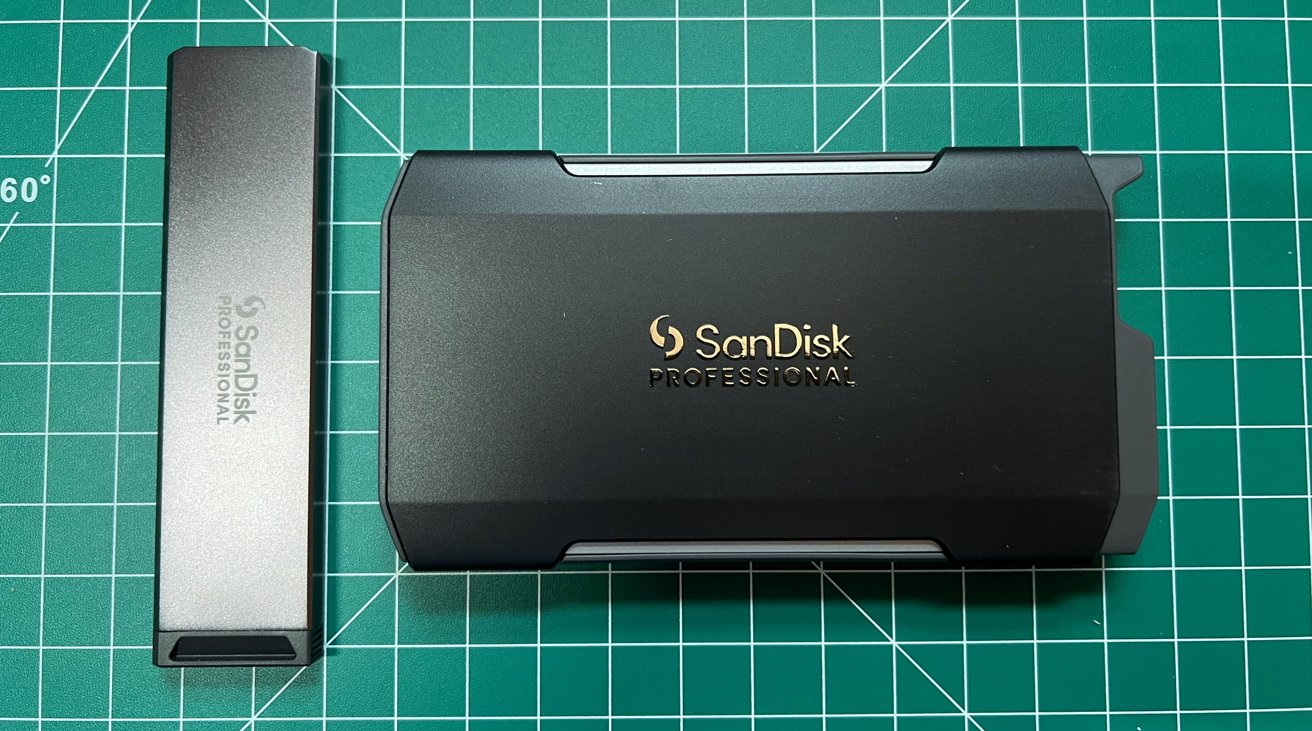
SanDisk Professional's Pro-Blade system is great for creative fields.
The nosebleed pricing of NVMe is justified by its blisteringly fast performance, which is reasonable on its own, especially if you have the need for it. It's more than enough for almost anyone to be able to work directly from the external drive without any real issues.
The problematic bit is that this is a modular storage system with an extremely specific set of purposes in mind. It's to cut down the overall size of external storage if you need to use mountains of drives, and it's to make it as easy as possible to switch between physical drives.
The average user and even the "prosumer" has other, better options. However, videographers and the like working from the drive directly and using each one per project can then physically hand over to someone else, which is good from a flexibility standpoint. And, they're easy to store and label.
For that purpose, the SanDisk Professional Pro-Blade Transport and SSD Mags are a useful tool for data storage involving multiple drives. For other users, more traditional external storage drives are a better and more cost-effective than Mags and Transports.
Looking to the future, though, is where the Pro-Blade has potential. The Pro-Blade Station is a good start, with Thunderbolt connectivity.
If peripherals like the Pro Blade or some kind of Thunderbolt dock incorporating the Mags, with more ports and monitor connectivity becomes more ubiquitous, paired with adoption in devices that demand high speeds like video cameras, then we see a bright future for the technology.
Until then, though, we're not sure who's asking for this solution today, and there are better solutions for the M1 series of Macs. We'll revisit this in the future.
Updated February 15, 2:05 PM ET Updated with speed testing on a M1 Max MacBook Pro, versus the testing performed solely on a M2 Max MacBook Pro.
Read on AppleInsider

SanDisk Professional Pro-Blade Transport and SSD Mag
Most of the AppleInsider staff used Zip disks in their heyday. For those that didn't, they were portable magnetic media a bit larger than a floppy disk that slotted into a relatively inexpensive drive.
Most of the major manufacturers adopted them as at least an option. Apple did too.
But for many reasons, they faded into obscurity. Data density was one issue, and so was reliability on not just it, but its larger cousin, the Jaz drive. And, they were mostly replaced with flash drives.
Fast forward about two decades to today, and SanDisk has resurrected the idea of removable media in a custom enclosure with the idea of the flash drive, resulting in the SanDisk Professional Pro-Blade Transport system. The Pro-Blade ecosystem revolves around high-speed SSD "Mags," which are slimline and lightweight, and hold the actual media.
To interface them with your Mac, you at a minimum need the SanDisk Pro-Blade Transport. That enclosure is effectively the main enclosure for an external drive, but without the drive itself.
The theory is that you have one or relatively few Transports, but lots of SSD Mags. Tried and true model, once upon a time.
Pro-Blade Transport
Of the two types of component, the Transport is the bit that connects to your Mac. The SSD Mag fits into the Transport, which in turn communicates to the Mac.In effect, the Transport is a specialized hard drive docking station or "toaster." Except it's in a much smaller form.

The slot of the Pro-Blade Transport where you place the SSD Mags
Made from aluminum complete with an aluminum heatsink to help cool the SSD Mags, the Transport is a relatively straightforward docking element. On one end is the slot where the SSD Mag fits in, along with an indicator light.
The slot is made so that you can easily insert and pull out the SSD Mag, so that you can quickly switch between Mags without too much interference.
At the other end is just one port, a USB-C 3.2 Gen 2x2 connection with up to 20Gbps of bandwidth available to use. That is, assuming your Mac supports it -- more on this in a bit.

There's a 20Gbps USB-C port to connect the Pro-Blade Transport to your Mac.
As an enclosure, it's also reasonably sized at 5.13 inches long, 2.82 inches wide, and 0.63 inches thick. It's fairly lightweight when empty at 0.46 pounds. This is still much bigger than the recent crop of NVMe USB-C enclosures.
It can be used on both Macs and Windows, with support for macOS 10.13 or later and Windows 10, though you will have to reformat the Mags. For the former, it is compatible with Time Machine, though admittedly this is better suited for work-use drives rather than backups.
Pro-Blade SSD Mags
The actual storage bit of the system, the SSD Mags are long, thin slabs of aluminum with SanDisk branding in the middle. At one end is a divot to help grip the Mag when it's in the slot.The other end has the connector that couples to its counterpart deep inside the Transport. It will also work with the Pro-Blade Station, a more enhanced form of the Transport that can take up to four Mags.
However, this isn't a standard connector that will work outside of the system itself. You cannot directly connect the drive alone to your Mac, you must use the Transport.
Each Mag is very light at a tenth of a pound each. They're not quite as long at 4.32 inches, but they're also a lot thinner and narrower at 1.1 inches and 0.2 inches.

The SSD Mag's connector.
Despite their size, SanDisk worked to make each one durable. Away from the Transport, each blade can withstand a 3-meter (9.8ft) drop, and can survive being crushed by a 4,000-pound weight.
We did run one over with our minivan, and it survived, intact and readable. Scuffed, but intact.
So far, there are four different capacities of Pro-Blade SSD Mag available, including 1TB, 2TB, and 4TB versions, and all using NVMe storage
Assisted by the aluminum enclosure and the heatsink in the Transport, the SSD Mag is capable of read speeds of up to 2,000 megabytes per second.
Our testing bore this out. Read speeds on a M2 Max MacBook Pro routinely hit 1.92 gigabytes per second, and read speeds generally hovered at 1.86 gigabytes per second. We didn't see a significant decrease in speed over time.
After we had some questions about it, we tested on a M1 Max MacBook Pro. On those units USB-C connections are limited to 10 gigabits per second, versus the 20 that USB 3.2 2x2 provides, and 40, that Thunderbolt is capable of.
On the M1 Mac, we only got about a gigabyte per second read and write, half that on the new MacBook Pro.
Curious, we ripped one apart. The enclosure is held together with a trio of T5 screws, and a pile of thermal compound connecting the drive and the enclosure. Inside the 2TB capacity Mag is a tiny bridge board with a Mag connector, and a Western Digital SN750 NVMe SSD with 2GB of cache.
In theory, that drive could push over 3 gigabytes per second, and did when we moved it to a Thunderbolt enclosure. But, it can only push this much data for about 12GB of transfer. After that, speeds in the Thunderbolt enclosure dropped to about 1.6 gigabytes per second.
So, with that 20 gigabit USB-C connection on new machines, and certainly the 10 gigabit connection on M1 and older Macs, you are assured of steady-state performance at the claimed speeds.
A space-saving solution for professional users
SanDisk provided us two carriers and a few Mags for testing. We didn't get to test out the four-Mag $499 Pro-Blade Station, as it does not appear to ship until March.For the average user, the SanDisk Professional Pro-Blade modular storage system is overkill. Even Mac power users will have quite some trouble justifying this sort of purchase, and it's not because of the price.
Buying each Mag individually costs $179.99 for 1TB, $299.99 for 2TB, and $599.99 for 4TB, which is fairly reasonable when compared with the general NVMe market. The Transport costs $69.99 on its own, which is pretty good for a storage-free component.
There are bundles available of the Transport with each SSD Mag capacity, starting at $239.99 for 1TB then rising to $349.99 for 2TB and $579.99 for 4TB.

SanDisk Professional's Pro-Blade system is great for creative fields.
The nosebleed pricing of NVMe is justified by its blisteringly fast performance, which is reasonable on its own, especially if you have the need for it. It's more than enough for almost anyone to be able to work directly from the external drive without any real issues.
The problematic bit is that this is a modular storage system with an extremely specific set of purposes in mind. It's to cut down the overall size of external storage if you need to use mountains of drives, and it's to make it as easy as possible to switch between physical drives.
The average user and even the "prosumer" has other, better options. However, videographers and the like working from the drive directly and using each one per project can then physically hand over to someone else, which is good from a flexibility standpoint. And, they're easy to store and label.
For that purpose, the SanDisk Professional Pro-Blade Transport and SSD Mags are a useful tool for data storage involving multiple drives. For other users, more traditional external storage drives are a better and more cost-effective than Mags and Transports.
Looking to the future, though, is where the Pro-Blade has potential. The Pro-Blade Station is a good start, with Thunderbolt connectivity.
If peripherals like the Pro Blade or some kind of Thunderbolt dock incorporating the Mags, with more ports and monitor connectivity becomes more ubiquitous, paired with adoption in devices that demand high speeds like video cameras, then we see a bright future for the technology.
Until then, though, we're not sure who's asking for this solution today, and there are better solutions for the M1 series of Macs. We'll revisit this in the future.
SanDisk Pro-Blade Transport Pros
- High-speed transfers
- Quick switching between Mags
- Compact size considering the use of multiple drives
- Premium aluminum styling
- Great for video editors
SanDisk Pro-Blade Transport Cons
- Overkill and too costly for most users
- Not full 20 gbit/sec speed on anything but the newest 2023 MacBook Pro
- Non-standard connector limits use of SSD Mags outside of the ecosystem
Rating: 3 out of 5
Where to buy
Get the SanDisk Pro-Blade Transport with a 1TB SSD for $169.99, including a limited-time $70 discount. That reduced price is available from B&H or Amazon at the time of this publication.Updated February 15, 2:05 PM ET Updated with speed testing on a M1 Max MacBook Pro, versus the testing performed solely on a M2 Max MacBook Pro.
Read on AppleInsider

Comments
The photo shows a pretty dusty Macbook Pro 16” behind the SSD so I’m guessing that’s an M1 Pro/Max Macbook Pro? Is that what you tested the speeds on? With the latest Ventura I’m guessing? I’ve never bought a Gen 2x2 device since they never had a benefit for Macs before, so I can’t test it out myself on my M1 Ultra Studio.
This “mag” system seems designed for digital cinema cameras like the Blackmagic Pocket Cinema Camera 6K which supports recording to USB-C drives, but has no other affordances for attaching an external drive to the camera. Rather than having to unmount and remount an SSD drive on an external bracket attached to the camera, the mag reader housing can remain permanently attached to the camera and the mags can easily pop in and out.
Proprietary systems like this seem to come and go — see the G-Drive Evolution system for example — but it’s an interesting idea, hope it catches on.
Edit - updated the original text. The Mac Studio has 10 gigabit performance, the M2 Max at least has 20.
Since I work in film editing I have a keen interest in how quickly I'm able to copy several terabytes of data between drives. Thanks for the info!
Probably later in the Mac history, however: early-mid 90s.
Although, I've been saying that USB-C just needs to shake out in other aspects for a while. It may never fully shake out.
We don't recommend it for most, today, but it's fun. If they can convince camera manufacturers to adopt it, it'll be of wider interest.
We'll probably also be seeing some fast USB4 SSD options hitting the market soon this year too with hopefully sub-Thunderbolt pricing.
This is one of the best tech stock pick stories I've ever heard. Bravo!
Sandisk is my preferred memory card brand for my filming gigs so this seems like a win-win to me.
Good point Mike about 40Gbps USB4 offering an even better speed improvement than 20Gbps Gen 2x2, on most/all? Apple Silicon Macs, and also for less-than-Thunderbolt prices. Looks like right now a USB4 enclosure like Acasis plus a fast PCIe 4.0 SSD would cost about $400-500 altogether, not bad at all really.
For some reason I have a little superstition about putting a desktop SSD inside a portable enclosure, I have heard that portable drives can get different firmware to draw less power or otherwise operate well in a mobile context. But I have no evidence for this, and I know plenty of people do it, so I should probably just get over it!
2TB CFexpress camera cards with similar read/write speeds range in price from $600 - $1000, with one currently on sale at B&H for $400. This Sandisk PRO-BLADE 2TB Mag at $230 is a bargain in comparison.